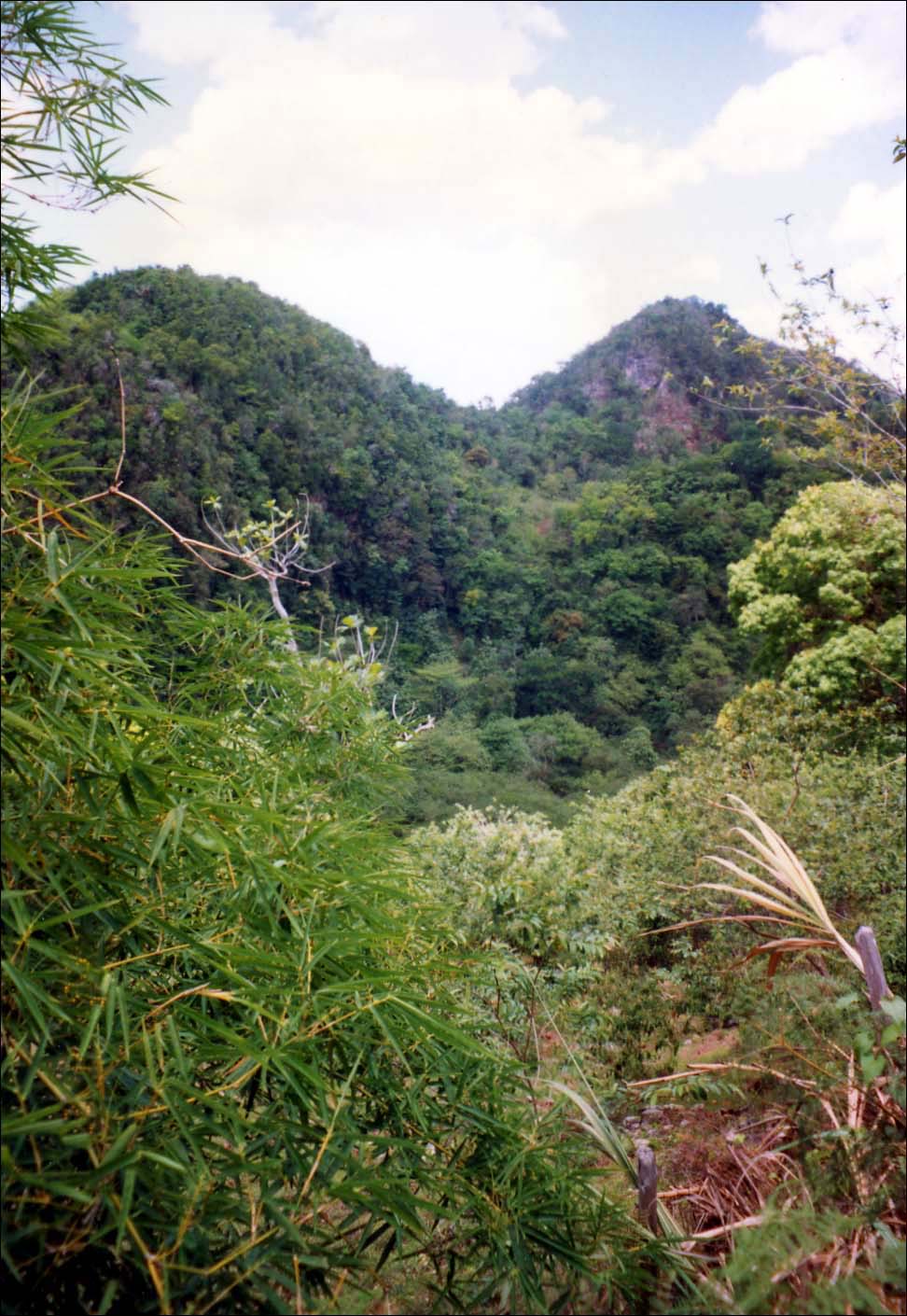
COCKPIT COUNTRY, JAMAICA

In 1655, when the British army and fleet failed to capture Santo Domingo, Spain’s most prized colony, Gen. Penn and Adm. Venables decided to take Jamaica so as not to return home empty handed. Lacking any organized defense, the Jamaican Spaniards fled to Cuba and released their slaves who, in the west, sought refuge in the inhospitable hills of the Cockpit Country. The “Maroons” here have a colorful history of outwitting and harassing the British who eventually negotiated a treaty in 1738. Sovereign lands were ceded to them and they were given the freedom and autonomy that slaves in the New World did not acquire for another 100 years. Their descendants still live in the Cockpit Country which remains uncharted and impenetrable.
 |
Karst Topography |
This rugged terrain is characteristic of the Karst topography that defines the area. Limestone is dissolved and removed by subsurface water resulting in underground caverns. As caverns develop, the water table is lowered and eventually the caverns collapse creating sinkholes that leave the land with the appearance of an inverted egg carton. No roads traverse the Cockpits. They are accessed only from the surrounding Maroon settlements.
In St. Elizabeth, the Cockpits are best explored from Accompong just north of Maggotty. The road to Accompong is narrow, winding and full of holes. From Accompong, there is a two hour hike to see the Peace Cave where Cudjoe, their Ashanti leader, signed the treaty with the British. Guided hikes are also available to the interior. Wherever there are trails, the land will be cultivated, especially in the valleys where soil has accumulated after being washed down from the hilltops. There are numerous caves and there is a rugged grace to the lay of the land with its razor-sharp limestone hills that drop precipitously to the valley floor. The trails stop where virgin forests remain. While anything is possible, penetrating this area is not recommended. Among the challenges involved is the fact that in many places, only a thin, brittle layer of rock remains over the deep caverns that have been eroded from below and the possibility always exists of plunging through the thin limestone into sinkholes of unknown depth.
In recent years, the Maroons have come to recognize the financial potential of tourism and they readily welcome visitors. If your visit is planned by a tour company, all formalities will have been taken care of for you. If not, you will need to pay a visit to Mr. Harris Cawley. He used to be the Colonel but he still retains much of the responsibility for visitors to the area. He will make all hiking arrangements including guides, porters and food. Hiking the Cockpits is a challenge and a unique opportunity to explore an area unfamiliar to most Jamaicans.
Best Times to Go:
Mornings
are best for short hikes because the hills are still misty and cool. For
campers, December to March is cooler and therefore more
comfortable.
Getting There:
From the main
road (A2), turn off at Lacovia beside the service station to take the road
north to Maggotty. Just past Maggotty as the road curves in an easterly
direction, there are signs for the road to Accompong to the north. Do not
hesitate to stop and ask for directions. It is easy to get lost in these
hills.
Clothing/Gear:
Comfortable
clothing and walking shoes, a light jacket, pants, rain gear, a hat with
brim, suntan lotion, insect repellent, compass, first aid kit and a water
bottle. If you plan to camp, you will need to bring an extra tent for your
guide.
General Information:
Hiking
costs are modest, about $25 per day per person, and include your guide
as well as a community assessment since the Maroons pay no taxes to the
Jamaican government and therefore, receive few services. Food and water
can be purchased but if you are only going on a day hike, it is best to
bring them with you. Bring enough to share with your guide. To make your
own arrangements, call Mr. or Mrs. Cawley before making the trip to
Accompong.
Your guide will be ready when you arrive and you will be able to get an
early start. Camping costs are slightly higher due to the need for porters
to transport your food and equipment.
Important Resources:
Countrystyle is a leading marketer of Jamaica’s country
life and specializes in providing alternatives to traditional ‘sea and
sand’ vacations. They are located in the Astra Hotel and will make all
arrangements to visit the Cockpit Country. Countrystyle specifically
addresses
the needs of independent travelers, environmentalists, botanists,
ornithologists,
and nature lovers. One of the more popular products is the “Countrystyle
Community Experience” day tour whereby visitors are able to share their
personal interests with similar minded Jamaicans.
PO Box 60
Mandeville, Jamaica WI
Tel: 876-962-3725
Fax: 876-962-1461
Email: countrystyle@mail.infochan.com
Accompong
Beth Salem P.A.
St. Elizabeth, Jamaica WI
Tel: 876-909-9222

Adventures Great and Small © copyright 1996-2005